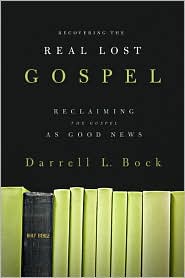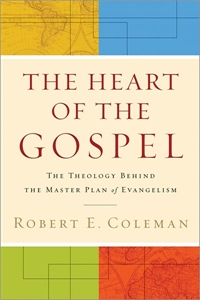
This review will soon be over at Credo Magazine's site as well. Look for it there. I have posted a preliminary copy of it here.
Recovering the Real Lost Gospel: Reclaiming the Gospel as Good News. By Darrell Bock. Nashville: B&H Academic, 2010.
When I first saw Darrell Bock’s Recovering the Real Lost Gospel, I thought that it was going to be a response to the discovery of some new “gospel” that allegedly called into question the four canonical Gospels. Dr. Bock has plenty of experience in this area, having spent a large portion of his academic career defending the biblical account of Jesus and the historical accuracy of the Gospels. His many books and articles on these topics have helpfully counteracted the various attacks and arguments against the truth of biblical Christianity.
After I picked up his newest book, though, what I found was both surprising and refreshing. Instead of defending the historical Gospel accounts from attacks outside of the church, Dr. Bock seeks to recover the Gospel message from distortions within the church. He explains, “This book is written with the conviction that the church has become cloudy on the purpose of the gospel…the goal [of writing this book] is to rediscover the gospel as good news, something that can be lost on the church today” (2).
Listen to an average sermon today and you will hear evangelistic presentations that suggest salvation is simply about obtaining a ticket to heaven, finding forgiveness, or soothing your conscience. Such messages leave sinners thinking that the Gospel is nothing more than an item on a checklist that has no lasting effect on their lives. But the biblical gospel is much more rich and full than these synthetic alternatives.
While it is certainly not less than a message about the forgiveness of sins and the hope of eternal life, the gospel is definitely more than this. In Dr. Bock’s words, “Its central proclamation is the good news of God’s love and initiative not only to save us from hell, but also to bring us into a healthy relationship with Himself. The point of this book is that the gospel is good news, and its core is a restored relationship with God” (1). It is this latter aspect of the gospel that has been lost by the church—the transformative power of the good news. In essence, the gospel not only saves; it transforms.
Although Dr. Bock’s book is brief (consisting of only 133 pages), it is thorough in its coverage of the gospel message. Chapter one traces the development of the gospel from the Old Testament to the New Testament, arguing that at the center of the gospel is a promise of a new community and relationship that is Spirit empowered. Chapter two looks at the gospel from the perspective of both the Lord’s Table and Baptism. The two images that emerge from these rites—a meal and a washing—illustrate what the gospel does for sinners: it washes them spiritually in order that they may have fellowship with God.
The third chapter, entitled “A Unique Action Meeting a Comprehensive Need,” discusses the perfect work of Christ on the cross as the sufficient payment for all sin. The great need that human beings had—salvation from sin—was met by the unique action of the Lord Jesus Christ—His sacrificial death on the cross. Building on this wonderful truth, chapters four and five reveal how the work of Christ is applied to human beings. Because Jesus Christ paid the debt of sin in full, nothing remains for sinful people to pay for. Salvation, then, is a gift of God’s grace that is given, not earned; received, not worked for. The amazing thing about this great work of redemption is that God Himself accomplished it, in the person of His Son. The deity of Jesus Christ is clearly on display in the gospel, and it is an essential component of the message of salvation.
Chapters six and seven cover the response to the gospel message and the results that follow this, respectively. The gospel calls people to repent and turn from their sin and embrace the Lord Jesus Christ in faith. Those who truly trust in the person and work of Christ are indwelled by the Holy Spirit and enabled to live a life pleasing to God. In Dr. Bock’s words, the gospel gives reconciliation and peace—it restores the relationship between sinful human beings and holy God—and it grants a new kind of power that transforms sinners into saints.
I could say a lot in appreciation of Recovering the Real Lost Gospel. In keeping with the brevity of the book, however, let me make just a few brief comments. First, Dr. Bock helpfully connects the gospel to the greater story line of Scripture. His book is really a biblical theology of the gospel. It rightly demonstrates that in order to fully understand the gospel we cannot simply study New Testament texts that talk about it; rather, we must also follow the progression of the gospel message from Genesis on through the entire Old Testament. The covenants of Scripture—the Abrahamic, the Davidic, and the New—all testify and point to the gospel that would be more fully revealed in the New Testament.
Secondly, Dr. Bock does a good job setting the gospel message in its first century context. Several times throughout the book he referred to an ancient practice or custom that shed significant light on a verse (see pages 12-14 for a good example). Moreover, his section on the deity of Christ (chapter five) provides good background information on Jewish theology at the time of Christ and also confirms the accuracy and historicity of the Gospel accounts.
Finally, in my estimation, Dr. Bock accomplishes his goal of “reclaiming the gospel as good news.” His holistic approach to the biblical gospel is a welcome antidote to the assorted reductionistic gospel messages offered in its place. Recovering the Real Lost Gospel is a profitable read, one which should find a place on every Christian’s bookshelf.

